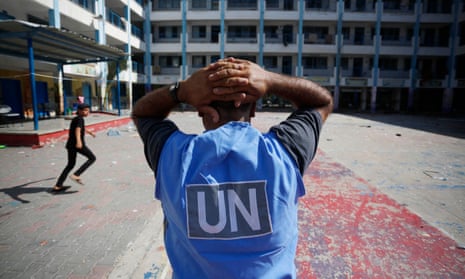The deaths of scores of aid workers in airstrikes on Gaza over the past month has made the conflict the deadliest ever for UN workers.
At least 88 people who worked for the UN’s agency for Palestinian refugees, UNRWA, have been killed since 7 October. Forty-seven of its buildings have been damaged.
Separately, at least 150 health workers have been killed in Gaza – 16 while on duty – and 18 emergency-service workers for Gaza’s civil defence, according to the UN. More than 100 health facilities have been damaged.
UN agency leaders called on Sunday for an immediate ceasefire and humanitarian access to the territory. They called for both Israel and Hamas to respect international law.
In a joint statement, signatories including the UN human rights commissioner, Volker Turk; Tedros Adhanom Ghebreyesus, head of the World Health Organization; and the UN aid chief, Martin Griffiths, said: “It’s been 30 days. Enough is enough. This must stop now.
“Civilians and the infrastructure they rely on – including hospitals, shelters and schools – must be protected. More aid – food, water, medicine and of course fuel – must enter Gaza safely, swiftly and at the scale needed, and must reach people in need, especially women and children, wherever they are,” they said.
UNRWA held a memorial service last week in the Jordanian capital, Amman, for colleagues killed in the conflict. The agency’s chief, Philippe Lazzarini, described those who had died as “extraordinary people who dedicated their lives to their communities”.
He said: “Thousands of our colleagues, despite the fact that they share the same loss, fear and daily struggle of millions of Gazans, put on their UN vest and go to work. They are our true heroes. They are the face of humanity during its darkest hours. I am deeply grateful to them and to you all.
“We will not give up our constant efforts to advocate for the protection of civilians and all UNRWA installations, and the uninterrupted flow of meaningful humanitarian aid to civilians, wherever they are in Gaza.”
The Palestinian Red Crescent Society said four of its medics had been killed and 21 people injured on duty, while eight emergency vehicles had been put out of service by damage caused by Israeli airstrikes.
It said a medic was injured when a convoy of ambulances was hit by what the society said were two Israeli airstrikes, the second outside the gates of Gaza City’s Dar al-Shifa hospital. The convoy was supposed to transport casualties to the Rafah crossing with Egypt for treatment but had to turn back because of damage to the roads.
“At all levels, we are dealing with a health disaster, from type of injuries to number of injuries. We already lost 150 medical personnel, as Israel killed them in airstrikes,” said Marwan Abu Saada, a senior surgeon at Dar al-Shifa hospital. “The situation is disastrous. We have zero capacity.”
The Catholic charity Caritas reported the death of a 26-year-old worker, Viola, with her husband and infant daughter, when an airstrike hit St Porphyrios Orthodox church, which had been sheltering about 500 people, including five Caritas staff and their families.
Aseel Baidoun, advocacy manager for the charity Medical Aid for Palestinians, said non-stop bombing had forced many UN services to halt their work, with staff moved to the south of Gaza. Other workers were taking risks to continue providing support, she said.
“They want to do more but they can’t. It’s an endless loop of frustration – of being so scared, not being able to help. Every doctor I talk to says we are living in a catastrophe, we can no longer function, we can no longer deal with the influx of injuries.”
